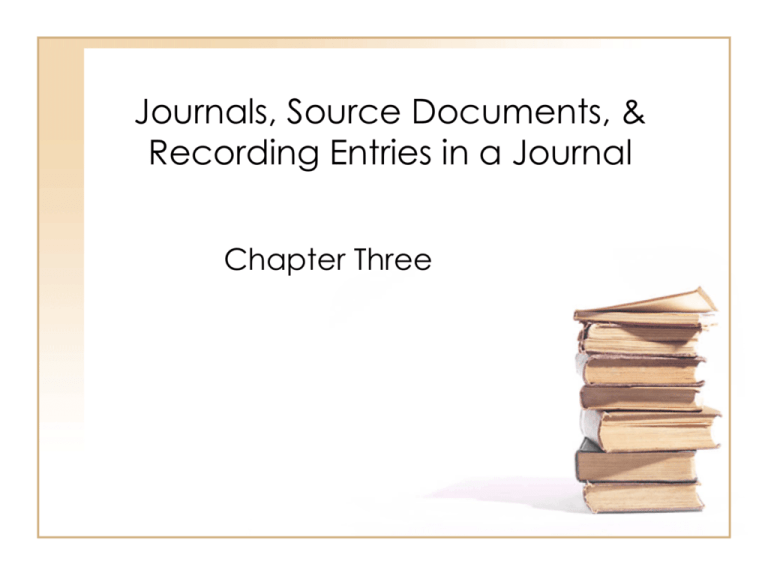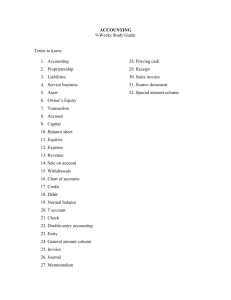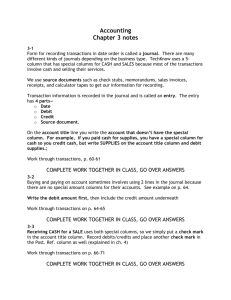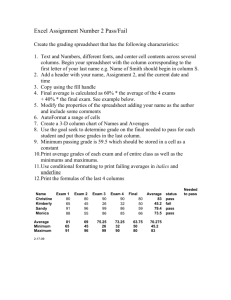Journals, Source Documents, & Recording Entries in a Journal
advertisement

Journals, Source Documents, & Recording Entries in a Journal Chapter Three Chapter Introduction After taking chapter 2 test, list all new vocabulary words for chapter 3 and write out their definitions. • Journal • Journalizing • Special Amount Columns • General Amount Columns • Entry • Double-entry accounting • • • • • • • Source document Check Invoice Sales invoice Receipt Memorandum Proving Cash Journals and Journalizing • Journal: form for recording transactions in chronological order. • Recording transaction in a journal is called journalizing. – Journal is permanent record – Fits the needs of the business • What determines the kind of journal used? – Nature of business – Number of transactions • Journalizing is done daily! Five-Column Journal Five Amount Columns – General Debit – General Credit – Sales Credit – Cash Debit – Cash Credit Special Amount Column: a journal amount column headed with an account title. • Used for frequently occurring transactions • Eliminates writing an account title in the Account Title column and saves time Three Special Amount Columns: • Sales Credit • Cash Debit • Cash Credit Five Column Journal General Amount Column: a journal amount column that is not headed with an account title. • General Debit • General Credit Facts about the Journal • Information recorded includes debit and credit parts of each transaction in one location. • Data can be verified by comparing journal to transaction data. • Transactions are recorded in chronological order. Journalizing Entry: information for each transaction recorded in a journal. Double-entry accounting: recording of debit and credit parts of a transaction. • Each transaction affects at least two accounts • A debit and a credit are recorded • Debits = Credits Source Documents Source Documents are business papers from which information is obtained for a journal entry. – – Each transaction is described by a source document that proves it occurred. Example: Check stub for each cash payment Objective Evidence: applied when a source document is prepared for each transaction. Five Source Documents • • • • • Checks Sales Invoices Receipts Calculator Tapes Memorandums Source Documents • Checks (Source document for cash payments) • Sales Invoices (Source document for recording a sale on a account) – Invoice: form describing the goods or services sold, the quantity, and the price. • Receipts – written acknowledgement for cash received (Source document for cash received from sources other than sales) – Example: Received Cash and an Investment – Calculator Tapes (Cash Sales) • Memorandums – a form for which a brief message is written describing a transaction. (Used when no other source document is prepared for a transaction or when an additional explanation is needed. Journal Entries A Journal entry consists of four parts: • Date • Debit • Credit • Source Document Use T accounts to help you! Journal Entry Examples Received Cash From Owner as an Investment, $5,000.00. Receipt No. 1 FYI – Dollar and cent signs, decimals are not used when writing on ruled paper Journal Entry Example August 3 -Paid Cash for Supplies, $275.00. Check No. 1 Remember: Writing Cash frequently could be time consuming- Special amount columns are used for these frequently used accounts Review 1. In what order are transactions recorded in a journal? 2. Why are source documents important? 3. List the four parts of a journal entry. Practice • Working Together • On Your Own • Application Problem 3-1 Review Look under your chairs – you may have a slip of paper 1. Read Your Question 2. Give the Answer 3. Prize Go Over Application Problem 3-1 Section 3-2: Journalizing August 4th – Paid Cash for Insurance, $1200. Check No. 2 Bought Supplies on Account August 7 - Bought Supplies on Account from Supply Depot, $500. Memorandum No. 1 Paid Cash on Account August 11 – Paid Cash on Account to Supply Depot, $300. Check No. 3 Practice Working Together On Your Own Journalizing Transaction that affect OE and Receiving Cash on Account August 12 – Received Cash from Sales, $295. Tape No. 12 Sold Service on Account August 12 – Sold services on account to Oakdale School, $350. Sales Invoice No. 1 Paid Cash for an Expense August 12 – Paid Cash for Rent, $300. Check No. 4 Received Cash on Account August 12 – Received cash on account from Oakdale School, $200. Receipt No. 2 Paid Cash to Owner for Personal Use August 12 – Paid cash to owner for personal use, $125. Check No. 6 Practice and Reviewing Section 3 • Working Together • On Your Own Section 2-3 • Audit Your Understanding p. 66 & 72 Homework Application Problems 3-2 and 3-3 Review Quiz 1. In what order are transactions recorded in a journal? 2. What are the four parts of a journal entry? 3. Why are source documents important? 4. What are the three special account columns? 5. What columns are used to record Received Cash from owner as investment? Section 3-4: Proving and Ruling a Journal When all but the last line on a journal page is used, columns are proved and ruled…. • Total are carried forward to the next page Steps in Proving a Journal: 1. Add each amount column 2. Add Debit column totals, Add Credit Column totals 3. Verify that Total Debits=Total Credit • • Journal page is PROVED If errors- must correct first Steps in Ruling a Journal Page You Must Use a STRAIGHT EDGE! • Rule single line across all amount columns – indicated that columns are to be totaled • On the next line, write date • Write Carried Forward in the Account Title column – checkmark placed on post ref. column • Write in column totals • Rule double line below totals – Indicates amounts are totals and debit=credits Starting a NEW JOURNAL Page • Write page number at top • Write date (year, month and day) • Write Brought Forward – check mark is placed in the post ref. column • Record column totals from previous page Proving and Ruling at the End of the Month • Rule single line to indicate columns will be added • Write date • Write the word Totals in the account title column – check mark is NOT placed in the post ref. • Write each column total • Rule double line debits=credits Proving Cash Determining that the amount of cash agrees with accounting records… 1. Add Cash at beginning and Cash Debit Column 2. Subtract Cash paid out- Cash Credit column 3. This equal cash balance at the end of the month 4. Compare to checkbook balance – next unused check stub. Practice • Section 2-4 – Working Together – On Your Own – Application 4 • Work on Application Problems 5 Review • Quotes/ Brainteasers • Audit Test • Go over Homework Standard Accounting Practice Procedures for error corrections, abbreviated words, signs and rulings. • Popcorn reading • Write on the board • Students make a list Practice & Application • Crossword Puzzle • Applications Problems 6-6 • Homework 6-7 Review • • • • • Catch Phrase Study Guide Review Game Audit Test Chapter Three Test





